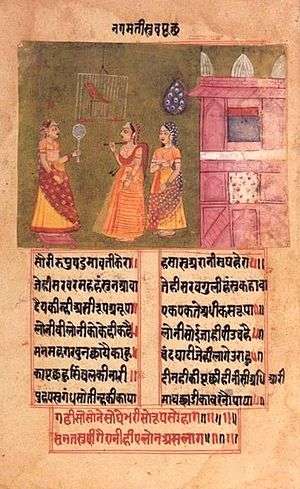Padmavat

बोलहु सुआ पियारे-नाहाँ । मोरे रूप कोइ जग माहाँ ?
सुमिरि रूप पदमावति केरा । हँसा सुआ, रानी मुख हेरा ॥
(नागमती-सुवा-संवाद-खंड)
"Who is more beautiful, I or Padmavati?,
Queen Nagamati asks to her new parrot, and it gives a displeasing reply…"; ---- An illustrated manuscript of Padmavat, c. 1750
सुमिरि रूप पदमावति केरा । हँसा सुआ, रानी मुख हेरा ॥
(नागमती-सुवा-संवाद-खंड)
"Who is more beautiful, I or Padmavati?,
Queen Nagamati asks to her new parrot, and it gives a displeasing reply…"; ---- An illustrated manuscript of Padmavat, c. 1750
Padmavat or Padmawat (Hindi: पद्मावत) is an epic poem written in 1540 by Malik Muhammad Jayasi in the Awadhi language. It is the first important work in Awadhi.[1]
Theme
This epic poem is a fictionalized version of the historic siege of Chittor by Alauddin Khilji in 1303 AD, who attacks Chittor after hearing of the beauty of Queen Rani Padmini, the wife of King Rawal Ratan Singh.[1]
According to Jayasi, Chitor stood for body, Raja for mind, Ceylon for heart, Padmini for wisdom, Alauddin for lust, and Ashraf Jahangir Semnani as an ideal spiritual guide:
तन चितउर, मन राजा कीन्हा । हिय सिंघल, बुधि पदमिनि चीन्हा ॥ गुरू सुआ जेइ पंथ देखावा । बिनु गुरु जगत को निरगुन पावा ?॥ नागमती यह दुनिया-धंधा । बाँचा सोइ न एहि चित बंधा ॥ राघव दूत सोई सैतानू । माया अलाउदीन सुलतानू ॥ प्रेम-कथा एहि भाँति बिचारहु । बूझि लेहु जौ बूझै पारहु ॥
Some part of the work is dedicated to Sher Shah (1486–1545).
Cultural influence
The poem is the ultimate source of Albert Roussel's opera Padmâvatî (1923).
See also
- Padmâvatî, an opera by Albert Roussel
- Sandesh Rasak of Abdur Rahman.
References
- 1 2 Meyer, William Stevenson; Burn, Richard; Cotton, James Sutherland; Risley, Herbert Hope (1909). "Vernacular Literature". The Imperial Gazetteer of India. 2. Oxford University Press. pp. 430–431. Retrieved 2009-04-06.
External links
| Wikimedia Commons has media related to Chittorgarh. |
This article is issued from Wikipedia - version of the 11/28/2016. The text is available under the Creative Commons Attribution/Share Alike but additional terms may apply for the media files.